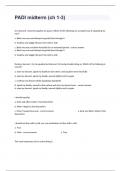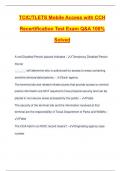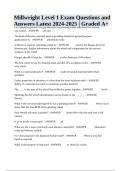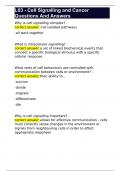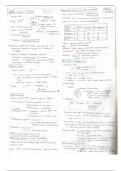Test Bank For
Auditing A Practical Approach 4 t h Edition by Robyn Moroney, Fiona
Campbell, Jane Ham ilt on
Chapter 1-14
CHAPTER 1
INTRODUCTION AND OVERVIEW OF AUDIT AND ASSURANCE
CHAPTER LEARNING OBJECTIVES
1. Define an assurance engagement.
An assurance engagement involves an assurance provider arriving at an opinion about
some information being provided by their client to a third party. A financial statement audit is
one type of assurance engagement. This engagement involves an auditor arriving at an
opinion about the fair presentation of the financial statements. The audit report is addressed
to the shareholders of the company being audited, but other users may read the financial
statements. Learning about auditing and assurance requires an understanding of auditing
and assurance terminology, including terms such as audit risk, materiality, internal controls,
listed entity, and assertions.
2. Explain why there is a demand for audit and assurance services.
Financial statement users include investors (shareholders), suppliers, customers, lenders,
employees, governments, and the general public. These groups of users demand audited
financial statements because of their remoteness from the entity, accounting complexity,
their incentives competing with those of the entity‘s managers, and their need for reliable
information on which to base decisions. The theories used to describe the demand for audit
and assurance services are agency theory, the information hypothesis, and the insurance
hypothesis.
3. Differentiate between types of assurance services.
Assurance services include financial statement audits, compliance audits, performance
audits, comprehensive audits, internal audits, and assurance on corporate social
responsibility (CSR) disclosures.
4. Explain the different levels of assurance.
The different levels of assurance include reasonable assurance, which is the highest level of
assurance, limited assurance, and no assurance. Reasonable assurance is provided on an
audit of a company‘s financial statements. Limited assurance is provided in a review of a
company‘s financial statements. No assurance is provided in a compilation engagement.
5. Outline different audit opinions
An auditor can issue an unmodified opinion, also known as a clean report, or an unmodified
opinion with an emphasis of matter paragraph. Alternatively, a modified opinion may be
issued as a qualified, an adverse, or a disclaimer of opinion.
6. Differentiate between the roles of the preparer and the auditor, and discuss the
,1-2
different firms that provide assurance services.
It is the responsibility of a company‘s governing body to ensure that its financial statements
are relevant, reliable, comparable, understandable, and true and fair. It is the responsibility
of the auditor to form an opinion on the fair presentation of the financial statements. In doing,
so the auditor must maintain professional scepticism and utilize professional judgement and
due care.
The firms that provide assurance services include the Big-4 international firms, the national
firms (with international links), local and regional firms, and consulting firms that tend to
specialize in assurance of CSR and environmental disclosures.
7. Identify the different regulators, legislation, and regulations surrounding the
assurance process.
Regulators of the assurance process include the Auditing and Assurance Standards Board
(AASB), Canadian Securities Administrators (CSA) and the various provincial securities
commissions, and the Canadian Public Accountability Board (CPAB). Relevant legislation
includes the Canada Business Corporations Act (CBCA). CPA Canada is the professional
accounting body in Canada, responsible for the Chartered Professional Accountant (CPA)
designation.
8. Describe the audit expectation gap.
The audit expectation gap occurs when there is a difference between the expectations of
assurance providers and financial statement or other users. The gap occurs when user
beliefs do not align with what an auditor has actually done.
, 1-3
TRUE-FALSE STATEMENTS
1. Only current investors (not potential investors) are considered to be users of the financial
statements.
Answer: False
Bloomcode: Knowledge
Difficulty: Easy
Learning Objective: Explain why there is a demand for audit and assurance services.
Section Reference: 1.2 Demand for audit and assurance services
CPA Competency: Audit and Assurance
AACSB: Analytic
2. Insurance hypothesis is a means whereby the investor can guarantee the success of their
investment.
Answer: False
Bloomcode: Comprehension
Difficulty: Easy
Learning Objective: Explain why there is a demand for audit and assurance services.
Section Reference: 1.2 Demand for audit and assurance services
CPA Competency: Audit and Assurance
AACSB: Analytic
3. A compliance audit involves gathering evidence to ascertain whether the person or entity
under review has followed the rules, policies, procedures, laws, and regulations with which
they must conform.
Answer: True
Bloomcode: Comprehension
Difficulty: Easy
Learning Objective: Differentiate between types of assurance services.
Section Reference: 1.3 Different assurance services
CPA Competency: Audit and Assurance
AACSB: Analytic
4. An operational audit is an example of a compliance audit.
Answer: False
Bloomcode: Knowledge
Difficulty: Easy
Learning Objective: Differentiate between types of assurance services.
Section Reference: 1.3 Different assurance services
CPA Competency: Audit and Assurance
AACSB: Analytic
, 1-4
5. The most common types of assurance engagements are financial statement audits,
confirmation audits, performance audits, comprehensive audits, and assurance on corporate
social responsibility (CSR) disclosures.
Answer: False
Bloomcode: Comprehension
Difficulty: Easy
Learning Objective: Differentiate between types of assurance services.
Section Reference: 1.3 Different assurance services
CPA Competency: Audit and Assurance
AACSB: Analytic
6. The nature of audit procedures refers to the reliance on evidence provided by the client
and its management.
Answer: True
Bloomcode: Knowledge
Difficulty: Easy
Learning Objective: Differentiate between types of assurance services.
Section Reference: 1.3 Different assurance services
CPA Competency: Audit and Assurance
AACSB: Analytic
7. It is the auditor‘s responsibility to prepare the financial statements.
Answer: False
Bloomcode: Knowledge
Difficulty: Easy
Learning Objective: Differentiate between types of assurance services.
Section Reference: 1.3 Different assurance services
CPA Competency: Audit and Assurance
AACSB: Analytic
8. An auditor can provide a reasonable level of assurance on information other than
historical financial information.
Answer: True
Bloomcode: Comprehension
Difficulty: Easy
Learning Objective: Explain the different levels of assurance.
Section Reference: 1.4 Different levels of assurance
CPA Competency: Audit and Assurance
AACSB: Analytic
9. A reasonable level of assurance is the highest level of assurance that an auditor can
provide.





